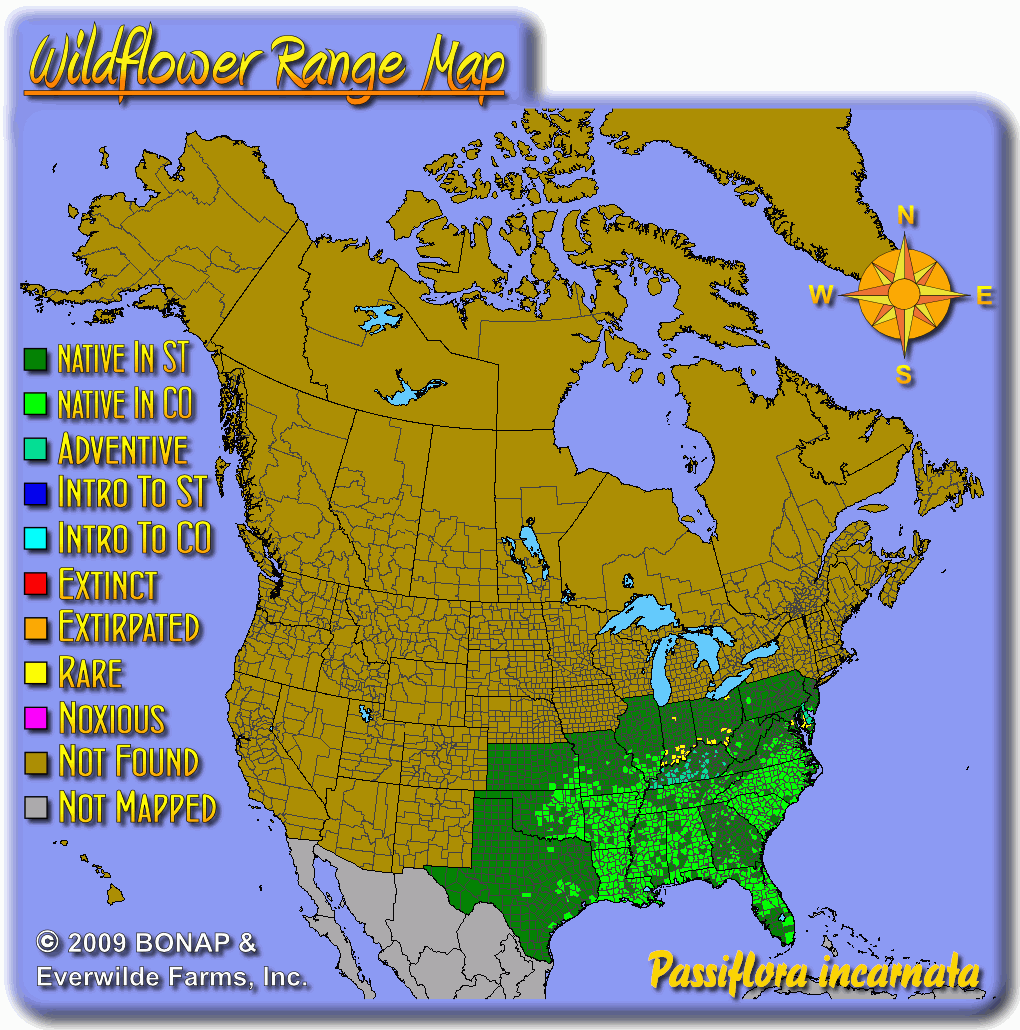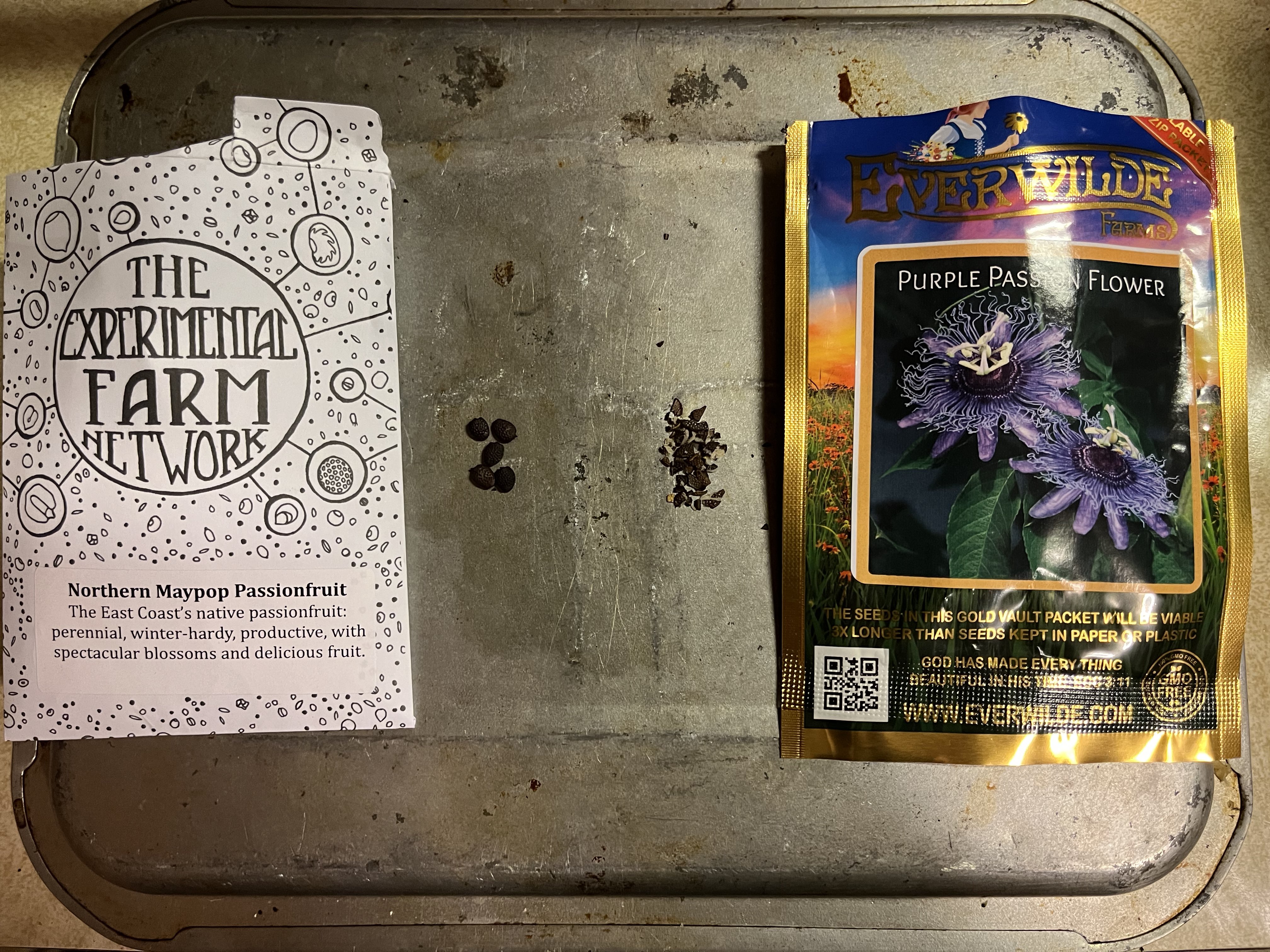Purple Passion Flower Seeds
- HOW TO GROW
- FAST FACTS
- REVIEWS
HOW TO GROW
Sowing: To help remove natural germination inhibitors on the purple passion plant seeds, soak them in a jar of water for 3-5 days; place the jar in the sunlight. Throw away the seeds that float, since they have most likely lost their viability. Plant the Passiflora Incarnata seeds 1/2" deep in a germination flat, and provide heat of at least 80 degrees F. Preserve consistent moisture and humidity by partially covering the flat. Time until germination can be difficult to predict, since it depends on growing conditions. Carefully transplant the seedlings once they can safely be handled and the soil has warmed.
Growing: Water seedlings occasionally until they become established. Mature plants tolerate drought well and prefer slightly dry soils. This vine makes an excellent choice for planting near a trellis, fence, or wall. If the vines begin to grow too thick, cut some of them back at ground level. In good growing conditions, they may spread vigorously; they also grow easily from root or stem cuttings, and can be divided. These blossoms are highly attractive to butterflies, bees, and hummingbirds. In spite of its tropical appearance, this plant can tolerate temperatures down to 0 degrees F.
Harvesting: For cut flowers, choose stems with flowers that have just opened. Strip the foliage that will fall below the water level, and place in water immediately. Harvest the edible fruits as soon as they give slightly when squeezed; they will still be very green in color. These fruits can be eaten fresh or used to make juice or jelly.
Seed Saving: Allow the fruits to ripen fully on the vine until they reach a yellow color, then remove them from the vine; open them to reveal the seeds in their gelatinous coverings. For best germination rates, plant the purple passion plant seeds directly from the fruit.
FAST FACTS
Common Names: Passionflower, Maypop Passionflower, Maypop, Passion Vine, Apricot Vine
Latin Name: Passiflora incarnata
Species Origin: US Native Wildflower
Type: Native Wildflowers
Life Cycle: Perennial
USDA Zones: 5, 6, 7, 8, 9, 10
US Regions: Plains/Texas, Midwest, Northeast, Southeast
Seeds per Ounce: 850
Stratification: Cold/Wet for 8 Weeks
Germination Ease: Stratify 8 Weeks
Sunlight: Full Sun, Part Sun
Height: 200 Inches
Color: Pink, Purple
Bloom Season: Blooms Early Summer, Blooms Late Summer, Blooms Early Fall
seed order
I ordered 9 different seed packs to plant later this month. Love the packaging that made it easy to plant indoors and/or stratify some now and save some for after last frost or fall planting. I had placed the order and saw a couple of other seeds I wanted so placed another order, both had shipping charges. It crossed my mind would be nice not to pay 2 shipping charges but I had placed two orders. When the order came I was only charged one shipping fee. Very nice surprise!
Purple Passion Flower
Was surprised at how easy these sprouted
Pulverized seeds
I was referred to this website by a a contact, and had high hopes for it seeing the attention to detail in the webpage design and the great selection & information. Unfortunately, the seeds I have received are crushed to tiny pieces, and I have no idea how this managed to happened. I would hope that, at the very least, it occurred during transit. It is my good fortunes, I suppose, that I accidentally ordered the same seeds from two different companies. Thank goodness, because at least now it's not a total loss with the growing season coming up soon. In the screenshot, it is clearly visible that the Everwilde seeds are not nearly as secure as the claims made, and they are outclassed entirely by this obscure competitor, which I may very well be giving all of my future business. Viable 3x as long, huh? Yeah, sure, good luck growing cracked casings and seed pulp.
Sorry to hear that your seeds arrived crushed! Of course we will gladly reship this tomorrow.  It does happen from time to time that the seeds get crushed going through the USPS rollers at their sorting facilities. Â
Review images:
title?
Haven't tried to grow these yet, but am hugely impressed with the prompt delivery! Faster than anyone else I have ever dealt with. I'm sure the seeds will be fine, but I won't know until next year, since the packet recommends sowing in Fall.
DESCRIPTION

HOW TO GROW
Sowing: To help remove natural germination inhibitors on the purple passion plant seeds, soak them in a jar of water for 3-5 days; place the jar in the sunlight. Throw away the seeds that float, since they have most likely lost their viability. Plant the Passiflora Incarnata seeds 1/2" deep in a germination flat, and provide heat of at least 80 degrees F. Preserve consistent moisture and humidity by partially covering the flat. Time until germination can be difficult to predict, since it depends on growing conditions. Carefully transplant the seedlings once they can safely be handled and the soil has warmed.
Growing: Water seedlings occasionally until they become established. Mature plants tolerate drought well and prefer slightly dry soils. This vine makes an excellent choice for planting near a trellis, fence, or wall. If the vines begin to grow too thick, cut some of them back at ground level. In good growing conditions, they may spread vigorously; they also grow easily from root or stem cuttings, and can be divided. These blossoms are highly attractive to butterflies, bees, and hummingbirds. In spite of its tropical appearance, this plant can tolerate temperatures down to 0 degrees F.
Harvesting: For cut flowers, choose stems with flowers that have just opened. Strip the foliage that will fall below the water level, and place in water immediately. Harvest the edible fruits as soon as they give slightly when squeezed; they will still be very green in color. These fruits can be eaten fresh or used to make juice or jelly.
Seed Saving: Allow the fruits to ripen fully on the vine until they reach a yellow color, then remove them from the vine; open them to reveal the seeds in their gelatinous coverings. For best germination rates, plant the purple passion plant seeds directly from the fruit.
FAST FACTS
Common Names: Passionflower, Maypop Passionflower, Maypop, Passion Vine, Apricot Vine
Latin Name: Passiflora incarnata
Species Origin: US Native Wildflower
Type: Native Wildflowers
Life Cycle: Perennial
USDA Zones: 5, 6, 7, 8, 9, 10
US Regions: Plains/Texas, Midwest, Northeast, Southeast
Seeds per Ounce: 850
Stratification: Cold/Wet for 8 Weeks
Germination Ease: Stratify 8 Weeks
Sunlight: Full Sun, Part Sun
Height: 200 Inches
Color: Pink, Purple
Bloom Season: Blooms Early Summer, Blooms Late Summer, Blooms Early Fall
Reviews
Review
seed order
I ordered 9 different seed packs to plant later this month. Love the packaging that made it easy to plant indoors and/or stratify some now and save some for after last frost or fall planting. I had placed the order and saw a couple of other seeds I wanted so placed another order, both had shipping charges. It crossed my mind would be nice not to pay 2 shipping charges but I had placed two orders. When the order came I was only charged one shipping fee. Very nice surprise!
Review
Purple Passion Flower
Was surprised at how easy these sprouted
Review
Pulverized seeds
I was referred to this website by a a contact, and had high hopes for it seeing the attention to detail in the webpage design and the great selection & information. Unfortunately, the seeds I have received are crushed to tiny pieces, and I have no idea how this managed to happened. I would hope that, at the very least, it occurred during transit. It is my good fortunes, I suppose, that I accidentally ordered the same seeds from two different companies. Thank goodness, because at least now it's not a total loss with the growing season coming up soon. In the screenshot, it is clearly visible that the Everwilde seeds are not nearly as secure as the claims made, and they are outclassed entirely by this obscure competitor, which I may very well be giving all of my future business. Viable 3x as long, huh? Yeah, sure, good luck growing cracked casings and seed pulp.
Sorry to hear that your seeds arrived crushed! Of course we will gladly reship this tomorrow.  It does happen from time to time that the seeds get crushed going through the USPS rollers at their sorting facilities. Â
Review images:
Review
title?
Haven't tried to grow these yet, but am hugely impressed with the prompt delivery! Faster than anyone else I have ever dealt with. I'm sure the seeds will be fine, but I won't know until next year, since the packet recommends sowing in Fall.







